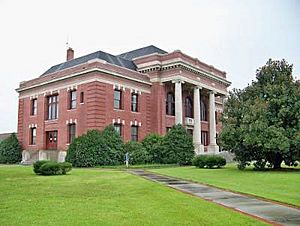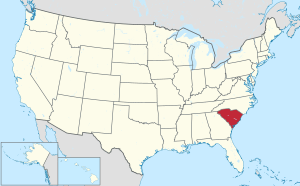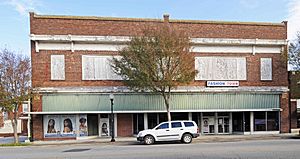Clarendon County, South Carolina facts for kids
Quick facts for kids
Clarendon County
|
||
|---|---|---|

Clarendon County Courthouse
|
||
|
||

Location within the U.S. state of South Carolina
|
||
 South Carolina's location within the U.S. |
||
| Country | ||
| State | ||
| Founded | 1785 | |
| Named for | Edward Hyde, 1st Earl of Clarendon | |
| Seat | Manning | |
| Largest community | Manning | |
| Area | ||
| • Total | 695.67 sq mi (1,801.8 km2) | |
| • Land | 607.21 sq mi (1,572.7 km2) | |
| • Water | 88.46 sq mi (229.1 km2) 12.72% | |
| Population
(2020)
|
||
| • Total | 31,144 | |
| • Estimate
(2023)
|
31,004 | |
| • Density | 51.29/sq mi (19.80/km2) | |
| Time zone | UTC−5 (Eastern) | |
| • Summer (DST) | UTC−4 (EDT) | |
| Congressional district | 6th | |
Clarendon County is a special area in South Carolina, a state in the United States. It's located in the Coastal Plain region, which is a flat area near the coast. In 2020, about 31,144 people lived here. The main town and center of the county is Manning.
This area was once known for its forests and mills, especially those that made cloth. Clarendon County is also home to Lake Marion, one of the biggest human-made lakes in the U.S. It was finished in 1941 as part of a big government project to bring electricity to rural areas. The dam that created the lake now makes electricity, which helps the local economy and businesses.
Clarendon County played an important role in the Civil Rights Movement. This was a time when people fought for equal rights for all, especially for African Americans. The county was involved in a court case called Briggs v. Elliott. This case challenged the idea of separate schools for different races. It became part of the famous Brown v. Board of Education case, where the United States Supreme Court decided in 1954 that having separate public schools for different races was against the law.
Contents
Exploring Clarendon County's Past
Clarendon County was officially created in 1785, right after the American Revolutionary War. It was named after Edward Hyde, 1st Earl of Clarendon, who was an important English nobleman.
Revolutionary War Battles
Many battles during the American Revolutionary War happened in or near Clarendon County. These include the Battle of Half Way Swamp, Richbourg’s Mill, Nelson’s Ferry, Fort Watson/Santee Indian Mound, and Tearcoat. You can learn more about these events and General Francis Marion, also known as the "Swamp Fox," by visiting the Swamp Fox Murals Trail, a historical landmark.

Early Settlers and Transportation
The first European settlers in Clarendon County were French Huguenots. They came by boat up the Santee River. Their families had moved to Charleston earlier to escape religious unfairness in France. Moving goods by land was hard, so canals were built to help boats travel around fast-moving parts of the river. The Santee Canal was a big one, built in 1793. But when railroads became popular in the mid-1800s, the canal was no longer needed and stopped working.
In 1798, Clarendon County was combined with two other counties to form Sumter District. This made it easier for the government to manage. Later, in 1855, Clarendon County became its own district again, with the same borders it had in 1785.
Plantations and the Civil War
Before the American Civil War, large farms called plantations grew crops like cotton in the county. Enslaved African Americans were forced to work on these plantations. The invention of the cotton gin made growing cotton very profitable. By the time of the Civil War, most people living in the county were African American.
In 1855, the town of Manning was chosen as the county seat, which is the main town where the county government is located. A man named Captain Joseph C. Burgess gave land for the courthouse and jail.
In 1865, near the end of the American Civil War, Union soldiers destroyed much of Manning, including the courthouse. The county took a long time to recover because it depended so much on farming, which struggled after the war. After the war, many African Americans worked as tenant farmers or sharecroppers. Over time, lumber and mills became more important, and towns grew along the new railroad lines.
Civil Rights Era
After a period called Reconstruction, white leaders in South Carolina passed laws that created segregation. This meant separate public places for different races. They also made it very hard for most Black men to vote. This unfairness continued for many years until African Americans worked hard to gain their rights. Federal laws were passed in the mid-1960s to make sure everyone had equal rights.
In 1941, Lake Marion was created by building the Santee Dam. This was part of President Franklin D. Roosevelt's New Deal plan to create jobs and bring electricity to many areas during the Great Depression.
Clarendon County was also involved in two important court cases during the Civil Rights Movement. These cases, Levi Pearson v. Clarendon County Board of Education (1947) and Briggs v. Elliott (1952), challenged segregated schools. These cases helped lead to the U.S. Supreme Court's decision in Brown v. Board of Education (1954). This ruling said that having "separate but equal" schools was against the law, because separate schools were often not equal and were unfair.
Clarendon County's Natural World
Clarendon County is in the east-central part of South Carolina. It covers about 607 square miles of land. Lake Marion adds another 95 square miles of water to the county. The land is mostly sandy, and the climate is mild, with warm summers and gentle winters. The county gets about 55 inches of rain each year. Farmers have a long growing season of 225 days, which is great for crops like cotton, tobacco, corn, and soybeans.
Clarendon County has a Humid subtropical climate, meaning it has hot, humid summers and cool, dry winters. It even holds state records for the most snowfall in 24 hours and the largest hailstone!
Protected Natural Areas
Clarendon County is home to several special natural areas that are protected:
- Bluff Unit National Wildlife Refuge
- Pine Island Unit National Wildlife Refuge
- Santee National Wildlife Refuge
There are also state and local protected areas:
- Bennett's Bay Heritage Preserve
- Hickory Top Wildlife Management Area
- Manchester State Forest (part)
- Oak Lea Wildlife Management Area
- Santee Dam Wildlife Management Area
- Santee Indian Mound and Fort Watson
- Taw Caw Creek Park
- Woods Bay Heritage Preserve
- Woods Bay State Park (part)
Rivers and Lakes
Important rivers and lakes in the county include:
- Black River
- Congaree River
- Cooper River
- Lake Marion
- Ox Swamp
- Pocotaligo River
Neighboring Counties
Clarendon County shares borders with these other counties:
- Sumter County – to the north
- Florence County – to the northeast
- Williamsburg County – to the east
- Berkeley County – to the southeast
- Orangeburg County – to the southwest
- Calhoun County – to the west
Main Roads
Several major highways pass through Clarendon County, making it easy to travel to and from the area. These include:
 I-95
I-95 US 15
US 15 US 52
US 52 US 521
US 521 US 301
US 301 US 378
US 378 SC 35
SC 35 SC 56
SC 56 SC 260
SC 260 SC 261
SC 261 SC 527
SC 527
People and Population
| Historical population | |||
|---|---|---|---|
| Census | Pop. | %± | |
| 1860 | 13,095 | — | |
| 1870 | 14,038 | 7.2% | |
| 1880 | 19,190 | 36.7% | |
| 1890 | 23,233 | 21.1% | |
| 1900 | 28,184 | 21.3% | |
| 1910 | 32,188 | 14.2% | |
| 1920 | 34,878 | 8.4% | |
| 1930 | 30,036 | −13.9% | |
| 1940 | 31,500 | 4.9% | |
| 1950 | 32,215 | 2.3% | |
| 1960 | 29,490 | −8.5% | |
| 1970 | 25,604 | −13.2% | |
| 1980 | 27,464 | 7.3% | |
| 1990 | 28,450 | 3.6% | |
| 2000 | 32,502 | 14.2% | |
| 2010 | 34,971 | 7.6% | |
| 2020 | 31,144 | −10.9% | |
| 2023 (est.) | 31,004 | −11.3% | |
| U.S. Decennial Census 1790–1960 1900–1990 1990–2000 2010 2020 |
|||
In 2020, there were 31,144 people living in Clarendon County. There were 13,161 households and 8,817 families.
Who Lives Here?
The county is a mix of different groups of people. In 2020, about 49% of people were White, and about 44% were Black or African American. Other groups, including Native American, Asian, and people of mixed races, also live here. About 3% of the population is Hispanic or Latino.
In 2010, the average age of people in the county was 41.4 years old. About 31.7% of households had children under 18 living with them.
Clarendon County's Economy
In 2022, the total value of all goods and services produced in Clarendon County was about $754.2 million. This means the county's economy is active!
Some of the biggest employers in Clarendon County include:
- The City of Manning
- The Clarendon County School District
- Helena Chemical (a company that sells farm products)
- McLeod Health (a healthcare provider)
- Walmart
Many people work in different industries across the county. The largest industries by number of jobs are healthcare, retail, and food services.
Water and Outdoor Fun
Clarendon County has lots of good quality groundwater. This means there's plenty of water for homes, businesses, and farms. Water comes mainly from sand layers deep underground. Wells can pump out a lot of water, sometimes as much as 1,500 gallons per minute! The water is clean and good to drink.
There are five public water systems in the county that provide water to communities like Manning and Summerton.
Clarendon County is a great place for outdoor activities! You can go boating, fishing, hiking, and hunting. There are also golf courses. The county is famous for catching large striped bass fish. Lake Marion hosts big fishing tournaments, including the Citgo/Bassmasters Tournament. Reader’s Digest magazine even called Lake Marion one of "America’s 100 Best" places for fishing, especially for catfish.
Hunting is also popular, with deer, turkey, and other small animals available. You can find places to practice shooting and hunting preserves in the county. There are also many hiking trails to explore.
News and Culture
Local News
- The Manning Times – a newspaper published every Thursday since 1882.
- The Clarendon Citizen – an online news website.
Arts and Entertainment
The Cultural Arts Center in Summerton and Weldon Auditorium in Manning are places where you can enjoy cultural events and artistic shows.
Communities in Clarendon County
Main City
- Manning (This is the county seat and the biggest community.)
Towns
Census-Designated Places
These are areas that are like towns but are not officially incorporated:
- Alcolu
- Foreston
- North Santee
- Wyboo
Other Communities
These are smaller communities that are not officially incorporated:
Schools
Clarendon County has several school districts:
- Clarendon School District 1
- Clarendon School District 2
- Clarendon School District 3
Famous People from Clarendon County
Many notable people have connections to Clarendon County:
- Bertie Bowman (1931–2023), a staff member who worked for the U.S. Congress.
- Marie Deans (1940–2011), an activist who worked against the death penalty.
- Joseph Armstrong DeLaine (1898–1974), a pastor, principal, and civil rights activist.
- Althea Gibson (1927–2003), the first African-American woman to win a major tennis championship.
- John C. Land III (born 1941), a long-serving state senator in South Carolina.
- John Lawrence Manning (1816–1889), who was the 65th governor of South Carolina.
- Richard Irvine Manning I (1789–1836), a legislator and the 50th governor of South Carolina.
- Marian McKnight (born 1936), who was crowned Miss America in 1957.
- Peggy Parish (1927–1988), the author of the popular Amelia Bedelia children's book series.
- James Burchill Richardson (1770–1836), the 41st governor of South Carolina.
- John Peter Richardson II (1801–1864), a legislator and the 59th governor of South Carolina.
- John Peter Richardson III (1831–1899), a legislator and the 83rd governor of South Carolina.
- Richard Richardson (1704–1780), a military general and legislator.
- Rob Thomas (born 1972), the lead singer of the band Matchbox Twenty.
Images for kids
See also
 In Spanish: Condado de Clarendon para niños
In Spanish: Condado de Clarendon para niños




